Andreas Fertner
Oct 10, 2023
The new Generation of Excel Alternatives

Category 1: Financial Modeling Platforms
Category 2: Data Collection Platforms
Category 3: Collaboration and Integrations
It's well-known that new innovation often emerges during times of crisis. As enthusiastic users of spreadsheets, we are excited to share some innovative platforms that have caught our attention, one of which is our own product. We aim to offer summaries for each platform, following the principle of giving a 'true and fair view.' We acknowledge that including our own product could introduce a degree of subjectivity, but we strive to be as unbiased as possible. In general, we're noticing trends towards easy-to-use integrations that work both ways—into the app and out from it—as well as features that are enhanced by large language models.
Category 1: Financial Modeling Platforms
Similar to how Oracle Hyperion Strategic Finance revolutionized complex strategic planning for large companies, emerging financial modeling platforms are often becoming essential for small and medium-sized businesses that rely on spreadsheets for financial planning and data analysis. These platforms allow for the creation of complex data models for a variety of applications. The added benefit is that these platforms often come with intuitive interfaces that minimize the need for extensive training.
Example Use-cases:
- Real-time cash flow forecasts that consider multiple variables such as seasonality, market trends, and past performance.
- Investment models that include different financial metrics like ROI, NPV, and IRR.
- Create different financial scenarios.
We first became aware of Causal from a hackernews post and its association with Naval Ravikant raised our interest. Causal allows users to create financial models by defining input and output variables, as well as various calculations. You can visualize these models through charts or tables. Switching to the dashboard view enables you to modify the input variables in real-time. The platform also has a sharing feature, making it easier to collaborate with team members.
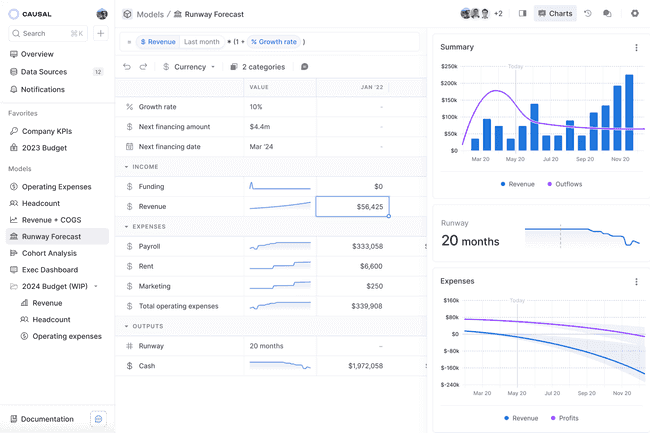
Causal offers seamless integration with a range of accounting systems like NetSuite, Xero and Workday. They even plan to offer an integration with SAP S/4HANA. Currently, the platform is geared towards the startup sector. Technically speaking, Causal employs a multidimensional model for its backend architecture. It appears that IBM Cognos TM1 has influenced its design, although it's not clear to us if they utilize a Radix Tree data structure.

Runway has received $27.5 million in Series A funding led by the venture firm owned by Garry Tan. The user experience is exceptional and reminds us of Notion. Even their website is superbly designed. The platform aims to offer seamless integration with over 400 data sources, such as QuickBooks, NetSuite, and Rippling. It also leverages artificial intelligence for insights and recommendations.
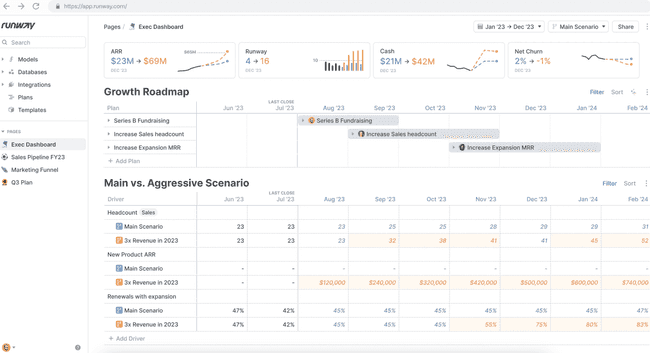
They have not yet had their public release, which is planned for 2024.
Category 2: Data Collection Platforms
Excel is a useful tool, but it can be challenging when you need to collect data from different people or teams within a company. Doing this every week or month can be tiring. While there are tools known as Corporate Performance Management Systems (CPM) that can help, they are often expensive, complex, and geared towards specific tasks like Financial Planning.
A new category of software tools is emerging. These software tools simplify and reduce the cost of gathering and organizing data from various departments in a company.
Interestingly, two companies that provide these new types of software tools are both bootstrapped and based in Austria.
Example Use-cases:
- Aggregate Monthly Sales Forecasts from Subsidiaries for Analysis.
- Capture Weekly Manufacturing Metrics by Plant.
- Collect ESG KPIs Across Subsidiaries.
colea lets you create templates to gather information from colleagues, departments, or subsidiary companies. When someone adds data, a dashboard shows the current status, such as 'open' or 'submitted.' Users can be prevented from submitting if certain checks are not met. The data gathered is automatically combined and can be used in different programs like Excel, Power BI, Tableau, or Qlik. To help users submit on time, you can set reminders and deadlines.
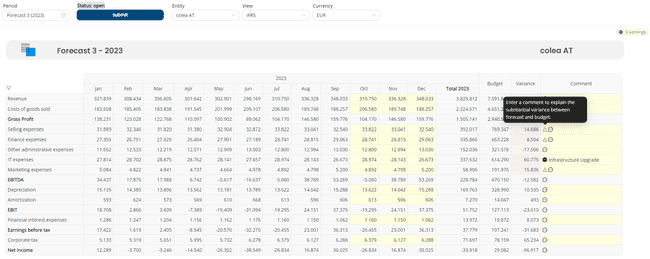
It offers an affordable option compared to traditional planning systems, bridging the gap between basic Excel templates and more complicated software.
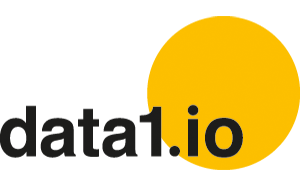
Data1.io is a versatile platform that offers both an Excel add-in for effortless data collection via template sharing and a robust cloud-based solution. If you have experience with Data Warehouses, you'll find the principles behind data1.io intuitively familiar. The workflow for creating data collection templates is designed for ease and efficiency, guiding you through steps such as 1. specifying dimensions, 2. selecting users, and 3. configuring workbooks, among others.
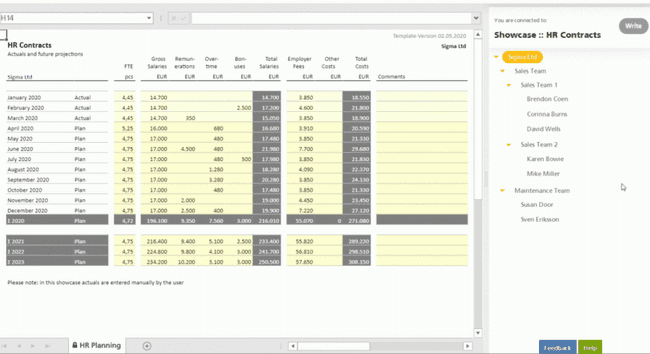
The user interface is very similar to Excel, as the app's functions are built into a conventional cloud-based spreadsheet.
Category 3: Collaboration and Integrations
This category includes platforms that are most similar to Excel, but with a modern UI and better connectors to 3rd party apps. It's also possible to automate source data refreshs via an included scheduler.
Example Use-cases:
- Real-Time Marketing Dashboards: Aggregate data from platforms like Google Ads and Facebook Ads.
- Live CRM Updates: Integrate CRMs for real-time customer data synchronization.
- Real-time Inventory Management: Integrate with e-commerce platforms to auto-refresh stock levels, alerting team members for restocking or excess stock.
Equals looks and feels like Excel. The platform comes with default interfaces to various finance systems such as NetSuite, as well as databases like Postgres and MSSQL. You can even join data from different data sources. One of its unique features is the ability to import scripts using Python, providing flexibility to pull data directly from REST APIs.
Users can quickly access functionality using a Command+K shortcut, similar to the spotlight search feature on MacOS. An AI prompt helps you complete formulas or create queries to source systems.
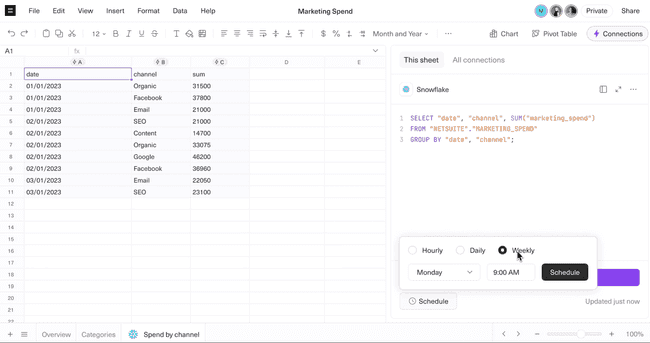
Overall, Equals.com aims to merge traditional spreadsheet functionalities with modern capabilities. This makes it a versatile tool for a wide range of tasks.
Rows takes you straight to a workspace for a quick start. If you want to see the main page, click here. The app has two main views: Edit View for changing the spreadsheet and Live View for user interaction. You can use parts of Rows in other apps like Notion through an iframe. Rows.com has ready-to-use templates for tasks like getting new leads or setting up marketing dashboards.
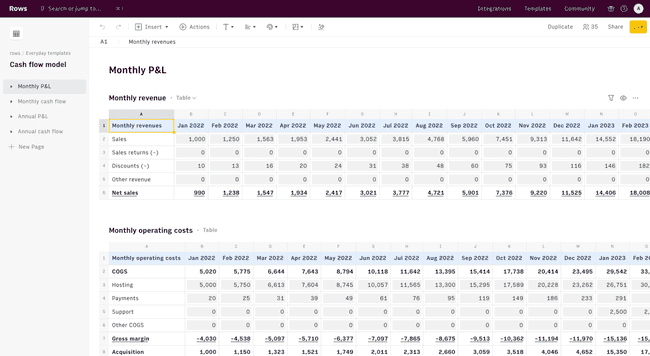
It also lets you load data from a variety of sources, like Google Analytics or SQL databases. Moreover, it has an AI wizard that lets you analyze data via text queries.
We're aware that there are many great new products on the market. We tried to select the ones that best align with the three categories we've identified. If we've overlooked a company that you think should be included, please contact us and we'll consider discussing the product in a future blog post.


